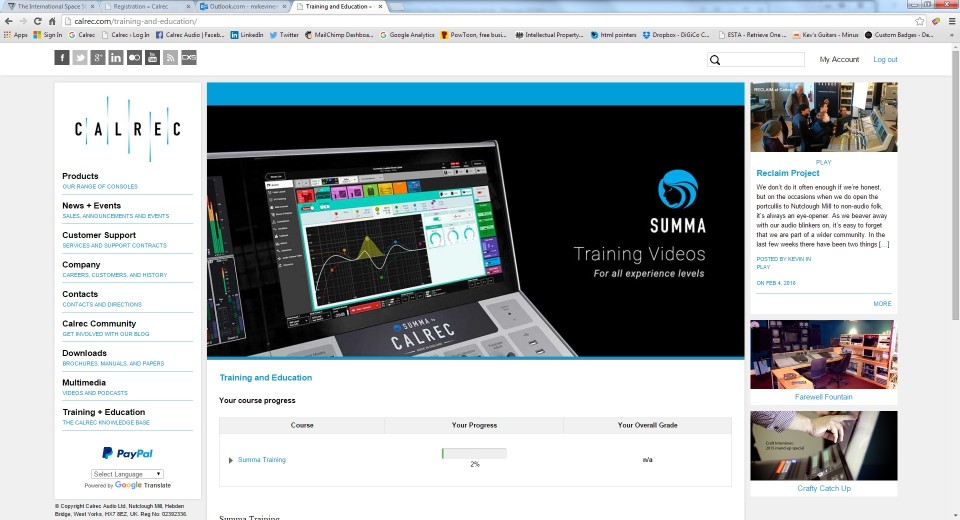Tech Focus: Broadcast-Audio Education, Part 2
For console manufacturers, training is still a good bet
Story Highlights
There is a growing number of formal propositions available for someone seeking training in broadcast audio. They range from four-year university programs to one-year associate degrees to online certificate modules. But the best options for cost-effective, hands-on training on specific platforms continue to be those offered by audio-console manufacturers.
The training can be at the manufacturer’s facility or at the user’s, via remote trucks configured for training or instructor visits to local venues. The cost of the training is negligible or even completely free; the quid pro quo for the manufacturer is a captive marketing audience. But given the growing diversity of platforms and their individualized interfaces, manufacturer-provided education is a great deal for all involved. Here are some of the programs available.
Calrec Audio
Calrec offers a free, comprehensive program of online training videos designed to educate operators on the complete setup and use of Summa, the company’s newest audio console, as well as on design philosophies and general audio-engineering principles. The Summa training course is divided into six modules, which are further broken down into chapters.

Calrec’s online training course introduces users to the Summa console, design philosophies, and audio-engineering principles.
These chapters comprise short animated videos that can be viewed in or out of sequence. Topics include channel strip controls, EQ, dynamics, fader controls, mix minus, creating channels, moving and cloning paths, memory management, on-air protection, and much more. Logging in ensures that progress is tracked to prevent users from repeating modules by mistake.
The Summa training course is part of Calrec’s increased focus on training over the past few years. The company’s audio primer is available as a free download for individual operators and freelance mixers. In the UK and the U.S., Calrec conducts periodic in-person Apollo/Artemis training at its facilities. Operators can also access the training videos, along with Calrec’s free audio and network primers, via calrec.com.
DiGiCo
For the past decade, DiGiCo has been hosting training at its UK head office, as well as in conjunction with various distributors at a number of locations around the world. In the U.S., its in-person Masters Classes travel to various cities, bringing consoles in for hands-on learning. This year, the classes will be in Nashville; Atlanta; New York; Baltimore; Dallas; Houston; Oklahoma; Las Vegas; Los Angeles; San Francisco; Durham, NC; Miami; and Orlando.
DiGiCo Online Training, the first tutorial of its kind for the pro-audio industry, broadens the access. Since a large percentage of the SD-user interface is common to all products, the SD9 console is used as the subject for this tutorial. The tutorial is split into three sections: a quick start for those who have never used a DiGiCo console before; an intermediate chapter that shows all major setup, functions, controls, and parameters; and an advanced section covering enhanced features, such as remote control, mirroring consoles, and programming for complex shows and system. Comprising about three hours of material, the content is divided into chapters specific to features and functions users may wish to gain greater knowledge of. All movies are HD and can be shown at full-screen size.
Lawo
In addition to training and support for customers, Lawo provides detailed product overviews and specific training on various product features at www.lawo.com and its YouTube channel, where users can view and follow instructional videos on practical application of Lawo’s products. The company also makes extensive use of social media for training, with updates about the newest training videos on its Facebook and Twitter accounts. The company’s regional product specialists in audio, video, and networking/control systems also are available to professional and technical schools in support of their efforts to educate and train the next generation of audio operators and engineers. Attendance at the company’s periodic regional training sessions as well as one-on-one training sessions can be arranged by contacting [email protected].
Studer
Launched in 2012, Studer’s original free Studer Broadcast Academy offered certification events at the Harman International campus in Northridge, CA, as well as Vista Foundation and Vista Intermediate modules for training aboard the Soundcraft Studer truck. In 2014, that program evolved into an online proposition in conjunction with the Conservatory of Recording Arts & Sciences (CRAS), which that year expanded its Master Recording program to include a broadcast-audio component focused on workflows and technologies specific to live television broadcast.
For CRAS students, the online Vista training is part of their larger curriculum; other professional engineers can access the same training, hosted on CRAS’s servers, via Studer’s branded portal, StuderBroadcastAcademy.com, through which students can operate Vista consoles using the Studer Virtual Vista software. The curriculum is broken down into eight short courses, taking a student from basic setup and workflow through to DSP configuration and IFB setup. The courses are written so that they can be taken in succession or as standalone tutorials, with an optional exam for official Studer certification at the end.
